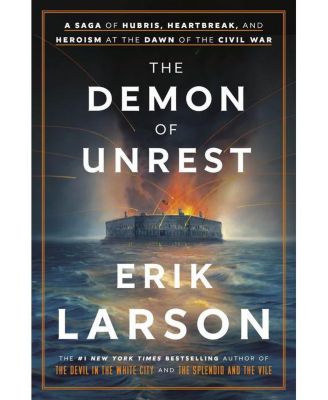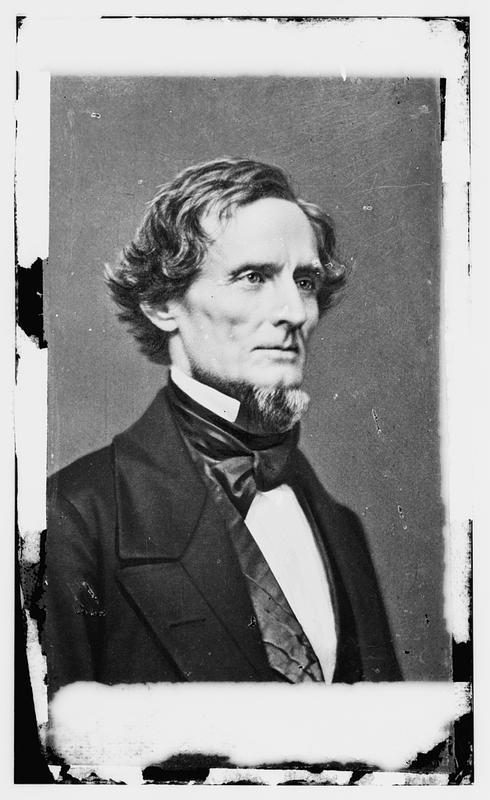The Demon of Unrest: A Saga of Hubris, Heartbreak, and Heroism at the Dawn of the Civil War by Erik Larson
Product details
Web ID: 19012568Mystic Chords of Memory
It is always amazing to discover a work offering fresh insights to events you thought you were familiar with. I have read several books, seen various video programs, and taken online courses on the subject of the American Civil War. To the point of feeling I had exhausted the subject for my level of satisfaction. And yet, along comes a new work with a different and enjoyable perspective of one key aspect of the war at the outset, namely, what triggers led to the four years of war, destruction and loss of so many lives. The work revisits the style of that memorable and original 1940s – 1950s radio, then TV, show “You Are There, with multiple perspectives as events were unfolding. Erik Larson’s 2024 “The Demon of Unrest”, is his non-fiction recreation of the events leading to the siege and surrender of Fort Sumter and the start of the American Civil War. Drawing from the diaries, letters and dispatches of key people at the time and an extensive list of related studies, the author brings you into the mindsets of key political, military and social figures, Union and Confederate. Following a short prologue, through seven sections Larson weaves the progress of events at Fort Sumter and the adjacent military posts around Charleston with the immediate situation leading to the outbreak of hostilities: • outgoing President Buchanan’s failure to address Southern hostilities; • the determined progress toward secession by the Southern planter class with giddy enthusiasm and selection of Jefferson Davis as their President; • the political maneuvering and pressure around newly elected, somewhat naïve, overwhelmed President Lincoln and his shifting perspective about preserving the Union before and after his first Inaugural Address; • the resolve of firebrands on both sides to have their wills prevail; • the determination of those defending Fort Sumter to perform duties despite rapidly mounting forces against them and confused attempts to provide timely relief. One striking theme throughout is the drive to justify secession was really about slavery. The argument for a state’s right to nullify participation in the Union, as proposed by South Carolina John Calhoun and his disciples, was a smokescreen to obscure the Southern planter bedrock beliefs that slavery was an acceptable, God given right to sustain their way of living, economically and culturally. As with his other successful works such as “Devil in the White City”, “Thunderstruck”, “Dead Wake”, Larson’s writing style and pace make for a comfortable, engaging read. Well worth the time spent.
Recommends this product
Customer review from barnesandnoble.com
Readable and well researched - Civil War
Fantastic, detailed information about the lead up to the Civil War. It is fascinating, engaging, and very readable. I learned so much.
Recommends this product
Customer review from barnesandnoble.com
Great writing
I really enjoyed Erik Larson’s historical nonfiction. His books are always so well researched. I found this book slower to get into than his other books. I found the book informative since I mostly read WW1 & WW2 nonfiction. It was a very detailed and well written account of Civil War events. My favorite Larson book is The Splendid and the Vile. I am giving it a 4.5 ⭐️
Recommends this product
Customer review from barnesandnoble.com
Highly recommend to those who aren't history buffs
Erik Larson is one of those truly gifted writers that welcome individuals into his arena of spellbinding storytelling and yet, you don't feel out of place or lost. His research is astounding and he presents history in a way that isn't boring but absolutely fascinating and you can't help but be sucked in to whatever the journey ahead unfolds to be, even, in this case, civil war. I have always been interested in just how we got to the point in our nation of battling each other, knowing that the tensions ran much deeper than what was taught in history books (thank you American education system, a mile wide but an inch deep). Erik really brings to life the tensions, the undercurrents, the total misunderstanding of each side and the brink of war that creeps closer and closer as each event unfolds. I highly recommend this to history buffs, but also those who aren't. What's more fascinating than truth of our past? *I received a copy of this book from NetGalley. This review is my own opinion*
Recommends this product
Customer review from barnesandnoble.com
Historical
Erik Larson has the ability to take specific times in history and summarize all the known information about it and then write a book that is entertaining , while educating. I tend to seek out books by Larson because, I have yet to find one, I didn’t enjoy. The other thing about reading a Larson book, is I think back on it, long after I am done reading it. This subject matter, Fort Sumter wasn’t anywhere on my radar but I didn’t hesitate reading it. I didn’t realize that’s was a few short months between Lincoln’s election and the shelling of Fort Sumter. Within those months so many things built up to ignite rhetoric powder keg that was the fort. The back and forth between Lincoln and Major Robert Anderson and the confusion and miscommunications also did not help the situation. Then Edmund Ruffin, intent on causing discourse, riled up the south and enjoyed the mayhem. We learn about poor Mary Boykin Chesnut, wife of an influential southern planter and conflicted between her feelings in slavery and wealth and all the problems that can cause, with her husband. Finally William Seward, who just wants to prevent war at all costs and tried is hardest to get that done but can’t seem to succeed. These are all individual characters who all had different views on war but who all had a lot to say. The trajectory of the war wasn’t theirs to predict but they tried. you can tell but the way the story reads that Larson did a phenomenal amount of research to tell this story. He dug deep and gave different perspectives, than I have read before. I love his style of writing and this book did not disappoint. We know a war was going to happen but I never realized the work done, by some, to avert it. This was a 4.5 read for me. I can’t wait to read the next book.
Recommends this product
Customer review from barnesandnoble.com
So much to enjoy and lament
Historians date the start of America’s Civil War with a rebel attack on Fort Sumter in April 1861. What Erik Larson adds is the suspenseful and dramatic series of events leading to the attack. In vivid detail, Larson describes a South emboldened by its self-righteous defense of slavery, and a North caught in transition between one president and another. The circumstances are remarkably like those following the 2020 Presidential election. Among them: • Fears that pro-slavery forces would disrupt the certification of electors. • Abraham Lincoln’s foes spread conspiracy theories that his election would embolden Southern slaves to arise and kill their owners. • The man authorized to count and certify the electoral votes was Lincoln’s primary opponent in the election. • On certification day, crowds of angry Southerners swarmed the Capitol, “firing off obscenities like grapeshot.” The hub of the Southern rebellion was South Carolina, whose harbor contained Fort Sumter and other federal outposts. In December of 1860, following Lincoln’s victory, the state’s leading political figures gathered in Charleston to declare their secession from the Union. The outgoing president, James Buchanan, ruled that if a state wanted to secede, the federal government could do nothing about it. Lincoln, who could not take power until his inauguration on March 4, had to bide his time while other Southern states joined the parade. Larson recounts the dilemma of Captain Robert Anderson, Fort Sumter’s commander, whose seventy-five starving men burned buildings and gun carriages to keep warm while two thousand South Carolina troops occupied nearby forts, mounted cannons, and stockpiled ammunition in preparation for an attack. Fearful of sparking a war, the federal government delayed a supply mission until it was too late. As he does in all his histories, Larson provides a sense of the times by plundering diaries, letters, memoirs, and other documents. Mary Chestnut, wife of a Confederate colonel, lived on a huge plantation with a lumber mill, grist mill, stables, forges, cotton gin, ice house, and quarters for hundreds of Black slaves. William Russell, an English journalist, described his astonishment at seeing spittoons and tobacco stains wherever he went. A visiting German reporter recalled Lincoln’s disarming humor when the two men took shelter from a rainstorm in a railroad car. There, Lincoln talked about his career and laughed, “Just think of such a sucker as me as President!” Larson even lists the household furniture Lincoln sold to pay for his inauguration trip to Washington. There is so much to enjoy and lament in this book. One can understand the buildup to war while recognizing the futility of it. The Civil War killed 750,000 Americans. Yet today, partisan anger divides us again. Erik Larson’s history is a five-star reminder that if it happened once, it could happen again.
Recommends this product
Customer review from barnesandnoble.com
Excellent book
You may think you know about Fort Sumter and how the Civil War began, but this book takes you there. I couldn't put it down.
Recommends this product
Customer review from barnesandnoble.com
Best book in a few years
Best book I've read in a few years. Thought I knew all about the Civil War. I've been to Fort Sumter, lived close to Fort Moultrie - I know SC's past. Boy was I wrong. This book (roughly 500 pages) goes into detail about everything from the time of Lincoln's winning the Presidency to just after Fort Sumter failed. And if you think you're gonna bog down in the details, ya don't. Of course I know the basic story, but I turned the pages quickly - I was stunned - maybe astonished - at the reasoning the South had for their slaves. I couldn't fathom any logic to their arguments. You've gotta read the book. And Mary Chestnut, the Yankee or North HATER - she got her comeuppance in the end. A character I'd never heard of - Edward Ruffin - stirred up various states to get them to secede. It's hard to know who hated the North more - Ruffin or Chestnut. But he also paid for his hatred in the end. I can go on and on but just get the book and be stupefied. I am still in disbelief.
Recommends this product
Customer review from barnesandnoble.com




